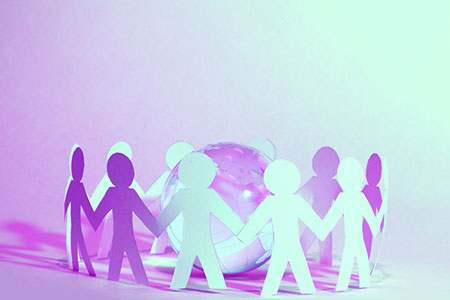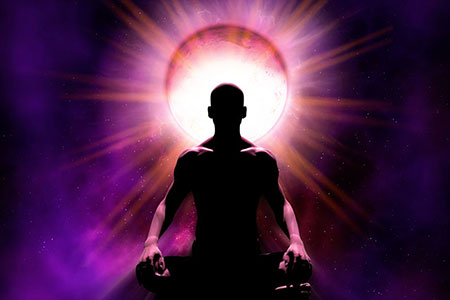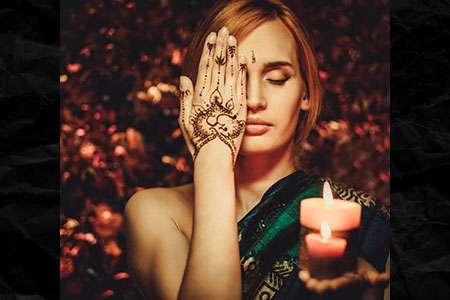Spirituality
The Cosmic Dance Of Life’s Challenges
 No matter where in the world you live, the seasons always change, albeit some may present with changes that are more subtle than in other places. While there may be an unexplained blizzard in Florida in March, the windswept islands of the Greater Antilles may be balmy year-round with few dramatic changes in weather.
No matter where in the world you live, the seasons always change, albeit some may present with changes that are more subtle than in other places. While there may be an unexplained blizzard in Florida in March, the windswept islands of the Greater Antilles may be balmy year-round with few dramatic changes in weather.
Wherever we live in the world, nature is a force all unto itself. It is sometimes predictable, while at other times intensely climatic, with extreme highs and lows.
As we all live on this big, green planet we call Earth, our human species is also subject to changes in our natural environment. We are all impacted by the seasons in some way, as well as climate unpredictability. It is an eternal cycle that impacts our crops, livestock and food supplies.
With nearly every turn we make, there is always an interconnectedness that is ever present – a reminder that our vast world is host to a greater macrocosm that supports each and every microcosm. In other words, Spirit, God, the Universe has our back!
The microcosm-macrocosm analogy is a reminder that there is a fundamental similarity that can be seen between the expression of life as we perceive it on this glorious planet, and the wider, infinite cosmos. Some philosophers have posited that a higher understanding of the cosmos may even be more closely inferred from the lessons of human nature, and vice versa.
Without expounding further on these mysteries, I believe we are bound on this plane by a natural ebb and flow that ushers in various degrees of change during many of life’s intervals. One lesson taught by life is that there is no growth without change. We see this in the natural world, as well as our personal lives. To move through various life stages requires fluid thinking, adaptability and purposeful actions.
How To Practice The Art Of Gratitude
 My life has not been without its challenges. Nevertheless, I love my job, have a beautiful son, an adorable husband and supportive friends and family. Therefore, irrespective of current world events, I genuinely have a lot to be grateful for!
My life has not been without its challenges. Nevertheless, I love my job, have a beautiful son, an adorable husband and supportive friends and family. Therefore, irrespective of current world events, I genuinely have a lot to be grateful for!
Gratitude is beneficial for all of us, including physically, emotionally and spiritually. For one, appreciating the good things in our lives helps us to be more tolerant and forgiving, with a higher sense of life satisfaction. Grateful people also tend to have more hope and inner peace and feel less anxious and alone.
God, Spirit, the Universe loves gratitude! Those who are sincerely grateful are blessed with even more to be grateful for. Like attracts like.
How does one ensure that you practice the art of gratitude ever day? The following guidelines should help:
Seek Out The Positive
In my own personal research into positive psychology, I became aware of something referred to as negativity bias. In case you have not heard of this, it means that our negative thoughts tend to be more dominant than the positive ones.
An excellent way of counteracting this negative way of thinking is to seek out at least three things in your life every day that you are well and truly grateful for. Try to make this a daily habit. By doing so, it should have you smiling in next to no time!
I remember when I was about 26 years old and in a particularly challenging place in my life. I was advised by a psychic, whom I reached out to with my troubles, to watch the film or read the book, The Color Purple by Alice Walker. It is some of the best advice I have every received. Once I had read the last chapter, I felt so grateful for whatever I had in my life.
Miracles Happen Every Day
 A miracle is described in the dictionary as “an event attributed to divine intervention”, and also referred to as “a phenomenon that defies the laws of nature”. The online Encyclopedia Britannica defines a miracle as “an extraordinary and astonishing happening that is attributed to the presence and action of an ultimate or divine power”. In certain translations of the Bible the terms “wonder,” “mighty work” and “sign” are also used to describe miracles.
A miracle is described in the dictionary as “an event attributed to divine intervention”, and also referred to as “a phenomenon that defies the laws of nature”. The online Encyclopedia Britannica defines a miracle as “an extraordinary and astonishing happening that is attributed to the presence and action of an ultimate or divine power”. In certain translations of the Bible the terms “wonder,” “mighty work” and “sign” are also used to describe miracles.
Most people would say that a miracle has occurred when the medical profession says there is no hope for a particular patient, and then, miraculously, the patient recovers fully, and without the complications which would have been expected connected to their condition.
But miracles are not necessarily always larger than life or dramatic. Miracles can happen for anyone at any time. And don’t expect an earthly explanation, or even to be taken seriously by everyone when the miracle has happened to you.
People have often told me of little miracles that have happened to them. For example, they don’t know how their bills will be paid, and out of the blue they receive a check in the post, or money is given to them, or they would win the exact amount needed to lift them out of their financial dilemma. Although I can’t prove it scientifically, I also know for sure that miracles have happened to me.
Two separate miracles I recall very vividly are both connected to my pets. A dog, and a cat named Miracle!
When my 5 year old Rottweiler, Sophia, was rushed to the vet with what we thought was an upset stomach, a burst duodenal ulcer and peritonitis were diagnosed instead. The vets had little hope, because even for strong humans this ailment can be life threatening.
Following the diagnosis, the vet phoned me and said they had to operate immediately. I asked if I could phone my husband and get back to them. I was informed with a sense of urgency that there was no time to do that, and even if they did operate on Sophia immediately there was very little hope.
We Can Co-Create A More Caring World
 Each part of our body has many functions, many parts. Some we can see and some, of course, we cannot. Each has a very important function and serves a role that helps our body to work and operate well.
Each part of our body has many functions, many parts. Some we can see and some, of course, we cannot. Each has a very important function and serves a role that helps our body to work and operate well.
For our body to continue to run well, we have to take care of all the parts. We must ensure, for example, that we don’t drink too much alcohol, or eat too many processed foods, because if we do it could ruin our health. But healthy living goes beyond our physical lifestyle. If we think negative thoughts, or are emotionally bitter or cynical, then we also promote disease in the human body.
It also goes beyond our own life and body. Our planet is also a living, breathing body and all the smaller parts of our wonderful world must also run smoothly, in order for nations and countries to survive and grow, and for all to live in peace and harmony.
If we all do our job, and we are all on the same team with the same values, such as harmony, love and peace, we could have a gloriously peaceful, harmonious world. We are aware of things like corruption, greed and dysfunctional politics. These evil practices go on and make for ripples of constant negativity. Sometimes we see it in horrible ways, where lives are ruined and destroyed.
We all have different talents and gifts. If we all listened to the messages from our higher consciousness, and acted on them, we could co-create a meaningful change in the world. If we all did our part, and maybe weren’t so complacent, and really listened and heeded our true calling, we may be able to work together – just like our body uses all of its parts to function. We are all one in spirit and we are all connected. We must all contribute.
Energy Protection For Children
 I just did a phone reading for client who said she was feeling as if “the life force has been sucked” from her, after she received an unexpected call from a former work associate.
I just did a phone reading for client who said she was feeling as if “the life force has been sucked” from her, after she received an unexpected call from a former work associate.
In hindsight, she says, this individual had always had this effect on her when they used to work together in the corporate field many years ago. She didn’t actually put two and two together at the time, but now she realizes that it was him who used to constantly drain her energy at work. At the time, she simply put it down to work stress and exhaustion.
She was surprised to realize that, even over the phone, certain individuals have that ability to drain us! We then discussed how she could even better protect herself psychically and shield her energy field from this former colleague and other energy thieves she may encounter in life.
An interesting aspect of energy protection and psychic shielding that is seldom considered is how children are affected by the people they connect with in life. Children are exposed to various social settings and energy environments that could be toxic and negatively affect their energetic well-being.
The veterinarian I rely on for my pets told me last week that he finds his work overwhelming at times. He feels it is due to the human owners of the pets, rather than the animals themselves.
At times, he says, he finds some pet owners really exhausting, as they bring both their anxieties about their pets, plus their own personal concerns with them. I could sense what kind of clients he had been dealing with to make him feel this way and believe me it was not a pretty sight!
He then asked me about his own two sons who are growing up now and how he could advise them to shield themselves in the future from the energy drain of people, and even social media. This made me think of the increasing number of clients who have been asking me the same question. How can I protect my child from people their energy, should they find themselves in a toxic environment?
How To Clear Your Karma
 Karmic cycles are repetitive patterns in consciousness that emerge through a belief that is contrary to the laws of the Universe.
Karmic cycles are repetitive patterns in consciousness that emerge through a belief that is contrary to the laws of the Universe.
Some religions and spiritual teachings refer to humanity as the ‘children of God.’ When I use the term ‘God,’ I do not mean some off-world deity that is separate from us mere mortals. To me God is the All. It is the Creative Force. Being a ‘child’ of this Creative Force means that we have the same nature and creative capacity.
Many wisdom traditions also equate words, thoughts and consciousness with God’s ability to create. In other words, thought has a creative function in the Universe. Thoughts are words, images, and stories that are repeated in the mind and they have creative power.
Another way of saying this is that whatever we choose to think or believe about ourselves and others, and about the world around us, ultimately becomes true for us. This is important when discussing how to clear away old karmic patterns.
Karma are patterns of thought that are repeated in the mind and influence how we create our life experiences. Free will means that we have total freedom in what we choose to think and believe.
This is not to say that a specific thought, or even a behavior, is wrong or bad. In fact, the Universe or God always takes us at our own value and says yes to all our thinking and feeling patterns.
Karma is a secondary spiritual law to the Law of Attraction, that allows us to evolve continually into our higher potentials. From an esoteric or spiritual perspective this relates to the expansion of love, joy, and peace within our mind.
Karma and the Law of Attraction are also separated by a protective buffer, in that we often experience less damage than our minds can produce through thought, and we also receive more good than our minds can produce through thought. In metaphysics this is known as the Law of Grace. Continue reading
